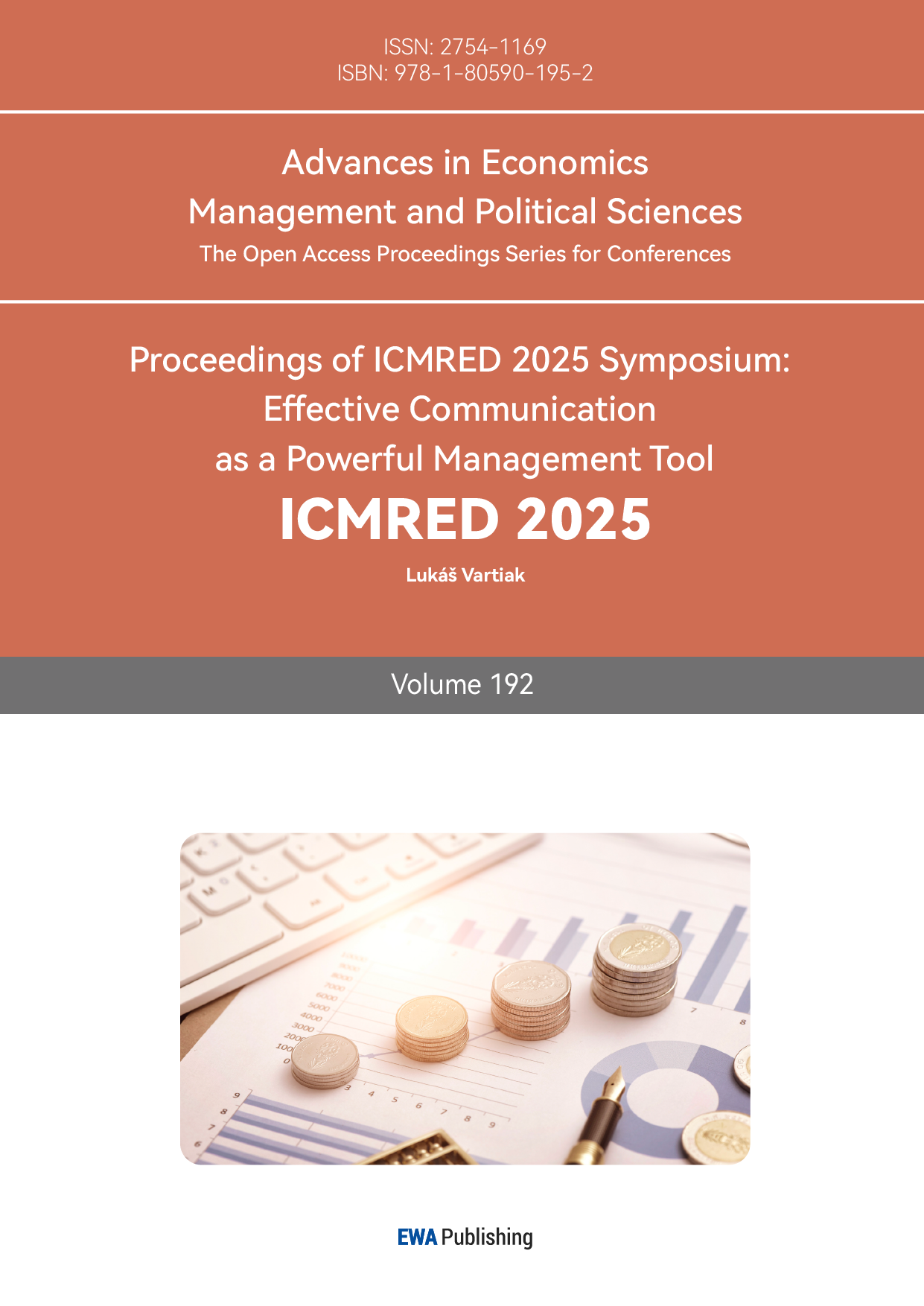1. Introduction
The interactive relationship between unemployment rate and economic growth has always been the core proposition of macroeconomic research. Since Okun proposed the empirical law of output gap and unemployment changes, "Okun's law" has become an important tool for analyzing economic cycles and labor market dynamics. In the past few decades, a large number of studies realized that the applicability of Okun's law varies greatly for different economies and different groups. For example, Ball found that Okun coefficient was only about half as large in developing as in advanced countries [1]. An et al. found that advanced economies are more consistent with Okun's law, while emerging markets and developing economies are less susceptible to Okun's law [2]. Okun's law is more applicable in economically developed countries. In many poor countries or emerging economies, unemployment rates are less sensitive to economic changes, and sometimes there is no negative correlation between the two.
This study classifies 126 countries in more detail based on their economic development levels from 1990 to 2022, and analyzes the differences in the applicability of Okun's law in different situations through the different characteristics of these countries. This article attempts to capture national heterogeneity from a multi-dimensional classification and explain the conditional sensitivity of Okun's law from more aspects. The following is structured as follows: the second part explains the data and methodology, the third part expands the data analysis, the fourth part makes a further discussion about the influence of AI technology on employment, and finally summarizes the research inspiration.
2. Data
This study uses demographic and economic data from publicly available sources, including the World Bank, United Nations World Population Prospects, and OECD databases. The data spans from 1990 to 2022, covering variables including population, GDP per capita, and unemployment rate.
In this study, in order to exclude the impact of extreme data and unrepresentative small countries, only countries with populations of 1 million in 1990 and complete data of GDP per capita were selected. In this way, 71 countries are excluded. To learn about features in countries at different stages of economic development, 126 countries are divided into three categories. The average GDP per capita (in constant 2017 international $) of these countries from 1990 to 2022 is used as a categorical indicator. 35 countries with mean values less than 4000 are classified as poor countries, 56 countries with mean values greater than or equal to 4000 but less than 20000 are classified as middle-income countries, and 35 countries with mean values greater than 20000 are classified as developed countries. This classification allows for an appropriate number of countries in each category, and most countries in the same category share some similar characteristics. For example, developed countries are generally highly industrialized and dominated by the tertiary industry. Many middle-income countries are undergoing industrial upgrading and transitioning from manufacturing to the service industry. Many poor countries are dominated by agriculture and resource-based industries and have a low degree of industrialization. These characteristics play an important role in analyzing the applicability of Okun's law.
To gain an initial understanding of the datasets, the article conducted descriptive statistical analyses to summarize the central tendencies, variability, and distributions of key variables, providing a comprehensive overview of the data prior to further analysis.
3. Results
3.1. Global differences in regional economic development levels and unemployment rate distribution
Figure 1 and Figure 2 show that the economies of North America and Europe are generally developed and other continents are generally lagging behind. This shows that developed economies have mature industrial structures, strong industrial innovation capabilities, and good social protection policies, which can provide more employment opportunities for the labor force [3]. The northern region is concentrated in South America, Asia and Africa, which are relatively scarce. This is closely related to backward technology, generally low education levels, and unstable social environment.
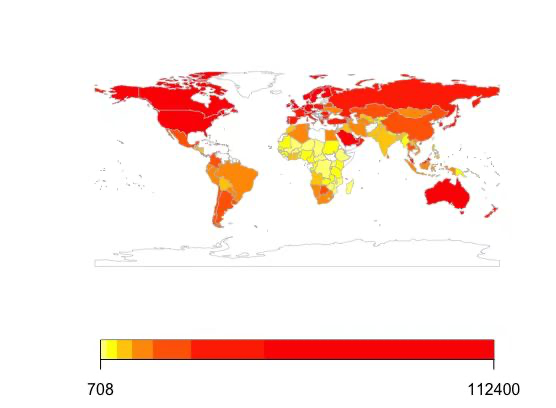
Figure 1: GDP per capita (2022) (picture credit: original)
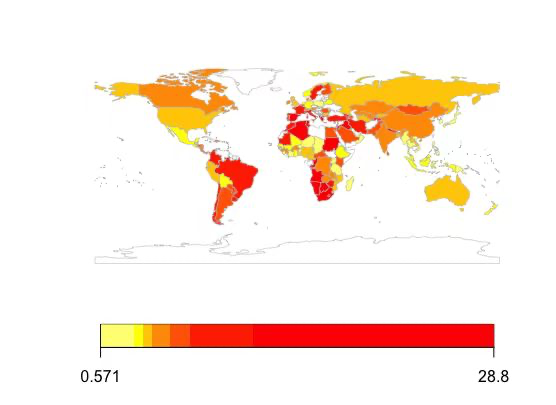
Figure 2: Unemployment rate (2022) (picture credit: original)
3.2. An overview of the relationship between unemployment rate and economic development in different economic
Figures 3 and 4 show that the relationship between the global unemployment rate growth rate and per capita GDP growth rate from 1992 to 2022 is generally consistent with Okun's law, that is, there is an inverse relationship between unemployment rate and GDP. Among different types of economies, the inverse relationship shown by economically developed countries is particularly obvious, with a pattern similar to one waxing and waning. Poor countries show a less clear relationship. In recent years, this reverse pattern has become even more pronounced. It shows that with economic development, the relationship between unemployment rate and GDP growth rate is more consistent with Okun's law. After the financial crisis in 2008, the unemployment rate increased significantly, and the GDP growth rate was greatly affected, especially in developed countries. According to Okun's law, the unemployment rate increases significantly during this stage, and economic growth slowdown or negative growth is also common.
The outbreak of COVID-19 in 2020 led to a surge in unemployment in most regions around the world, while per capita GDP fell sharply in some regions. All three types of economies showed a strong inverse relationship consistent with Okun's law.
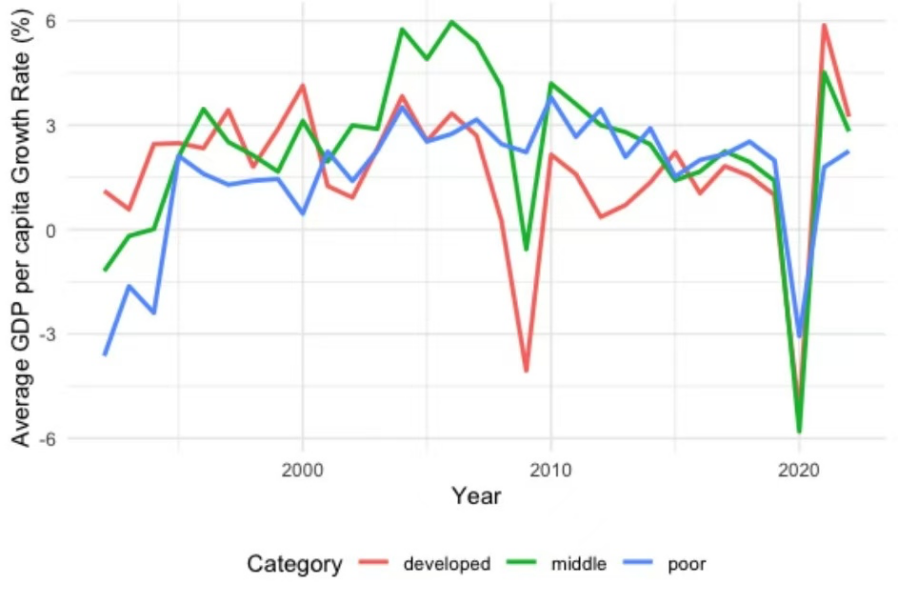
Figure 3: GDP per capita growth rate trend (picture credit: original)
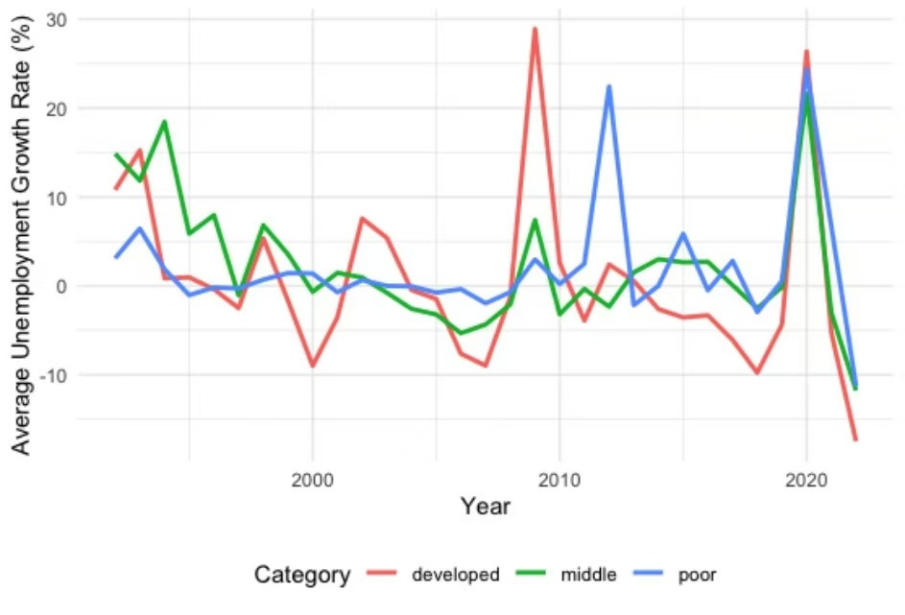
Figure 4: Unemployment rate growth rate trend (picture credit: original)
3.3. Applicability of Okun’s law to poor countries
Figure 5 selects five countries from poor economies: Haiti, Nepal, Democratic Republic of Congo, Pakistan, and Gambia. The GDP growth rate and unemployment rate change rate of these countries do not show an obvious negative correlation, and the regression lines are close to horizontal. This may be closely related to the economic structure, industrial development, and market characteristics of low-income countries. The flexibility of the labor market is relatively low, resulting in inflexible wage adjustments and thus a weak inverse relationship. High rates of informal employment in poor countries result in unemployment statistics in many countries failing to reflect the true situation [2]. At the same time, the low productivity and limited resources of these countries may also have a negative impact on the applicability of Okun's law. Economic growth in countries that are overly dependent on natural resources such as oil and minerals cannot generate employment. For example, GDP growth in the Democratic Republic of the Congo mainly comes from resource exports rather than labor-intensive industries. Pakistan's extremely weak negative correlation may be related to its high agricultural employment ratio, and GDP changes mainly come from industry and services rather than agriculture.
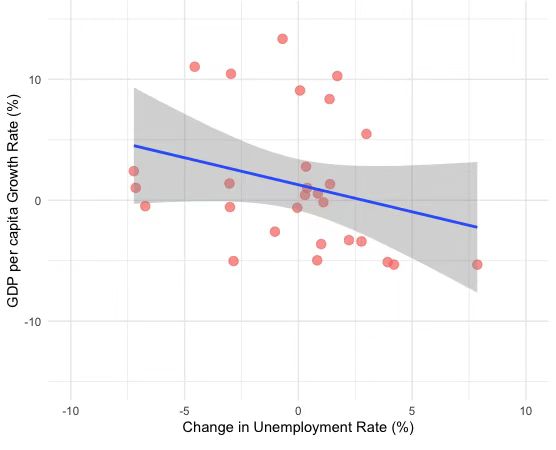
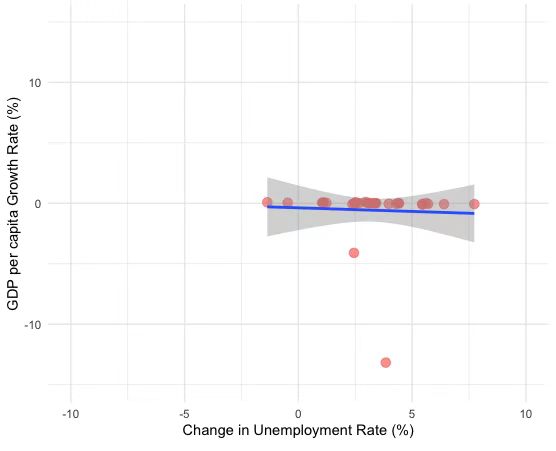
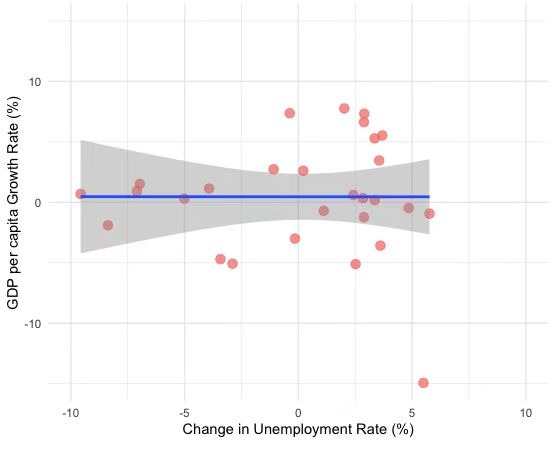
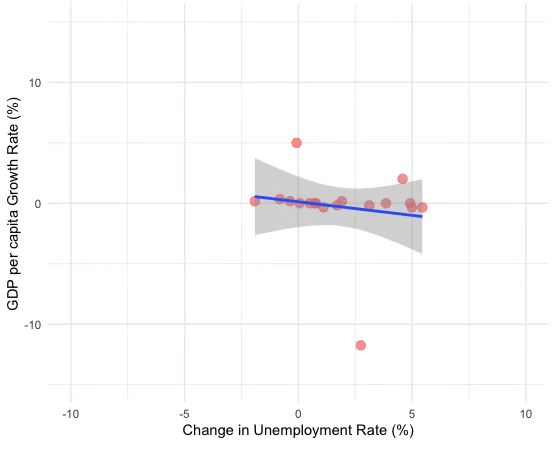
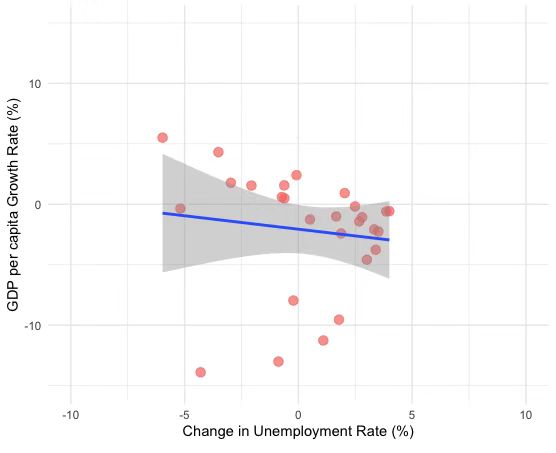
Figure 5: Change in Unemployment rate vs GDP per capita growth rate (from left to right and top to bottom: Haiti, Nepal, Democratic Republic of Congo, Pakistan, Gambia)
Notes: The figures are arranged from left to right and top to bottom. Figure 5 shows the relationship between change in unemployment and GDP per capita growth rate in Haiti, Nepal, Democratic Republic of Congo, Pakistan, and Gambia from 1992 to 2022. The red dots represent the observed data for each year, the blue line is the trend line obtained by regression fitting, indicating the linear relationship between the two, and the gray shaded area is the 95% confidence interval, showing the uncertainty range of the regression results. The figures are created by the author.
3.4. Applicability of Okun’s law to middle-income countries
According to Figure 6, five countries selected from middle-income countries generally conform to Okun's law, among which Brazil, Mexico, and Iran show strong correlation. Brazil has a very flexible labor market, and manufacturing and service industries dominate, which can clearly affect the data. Mexico has a very diverse economic structure, such as agriculture, manufacturing, and tourism. Moreover, Mexico is highly dependent on foreign trade. The export-oriented economy has a greater impact on global economic fluctuations, and the unemployment rate rises rapidly during economic recessions. In Iran, the energy sector dominates industry, and fluctuations in oil prices can have a significant impact on GDP and employment. Okun's law is relatively unobvious in South Africa and China. Reasons include both South Africa and China being subject to huge policy interference [4].
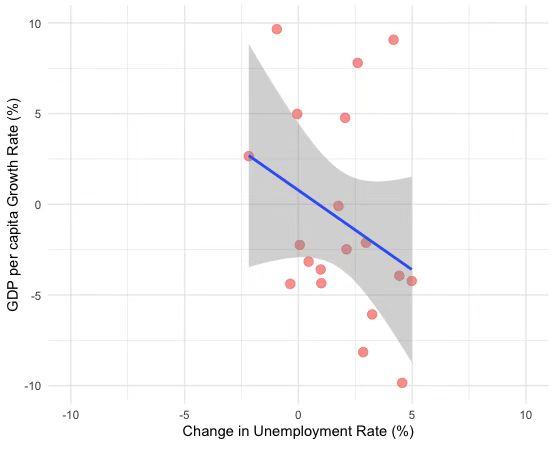
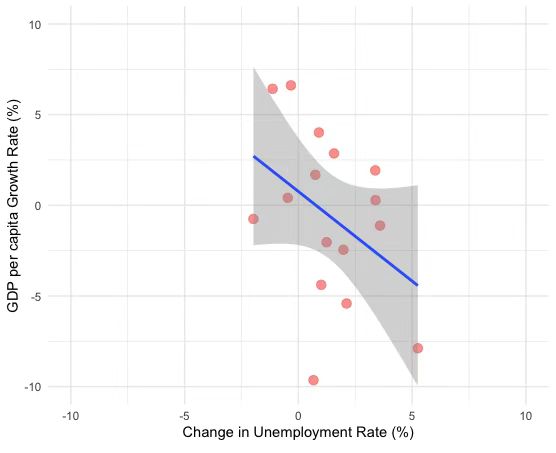
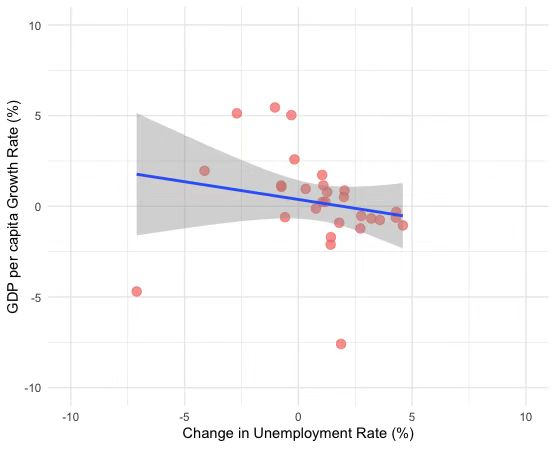
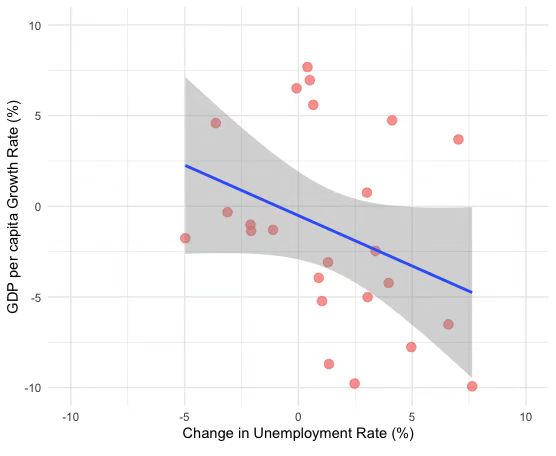
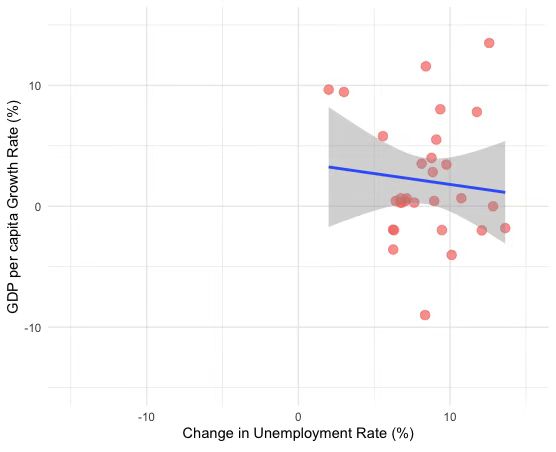
Figure 6: Change in unemployment rate vs GDP per capita growth rate (from left to right and top to bottom: Brazil, Mexico, South Africa, Iran, China)
Notes: The figures are arranged from left to right and top to bottom. Figure 6 shows the relationship between change in unemployment and GDP per capita growth rate in Brazil, Mexico, South Africa, Iran, and China from 1992 to 2022. The red dots represent the observed data for each year, the blue line is the trend line obtained by regression fitting, indicating the linear relationship between the two, and the gray shaded area is the 95% confidence interval, showing the uncertainty range of the regression results. The figures are created by the author.
3.5. Applicability of Okun’s law to developed countries
Figure 7 shows that economic development and unemployment rate in most developed countries also exhibit a relationship consistent with Okun's law. The labor market in developed economies is more affected by economic cycles, and companies will quickly adjust hiring and layoffs based on market conditions [5]. Germany, in particular, implemented Hartz reform in the early 2000s to train the unemployed, promote reemployment, and improve the flexibility of the labor market, making the impact of changes in GDP on employment more significant [6]. The relationship between unemployment and economic development in France is relatively weak. France's more rigid labor market and higher proportion of the public sector have an impact on this. The market is highly rigid and has a strong employment protection system, so GDP growth cannot create jobs quickly. Public sector employment is also less linked to market cycles. These countries that comply with Okun's law have demonstrated flexible labor markets and mature and complete industrial structures.
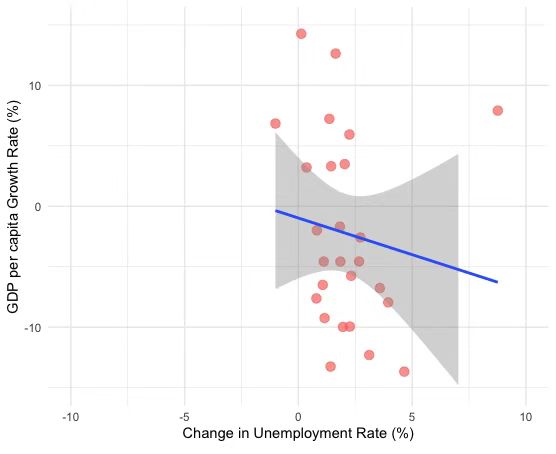
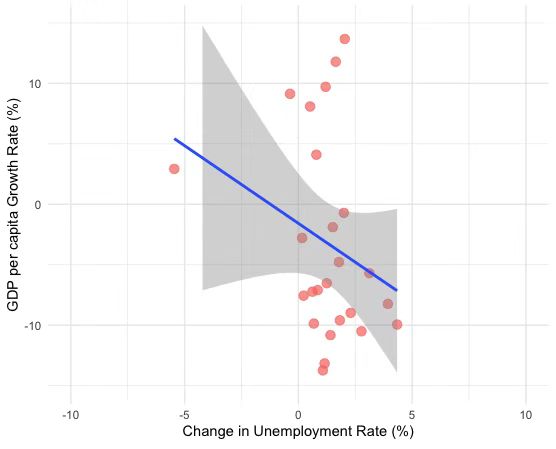
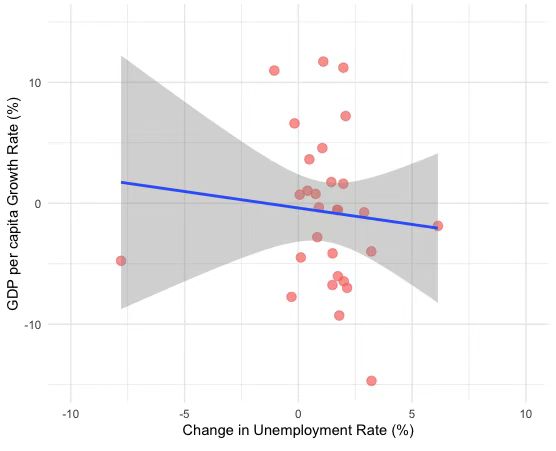
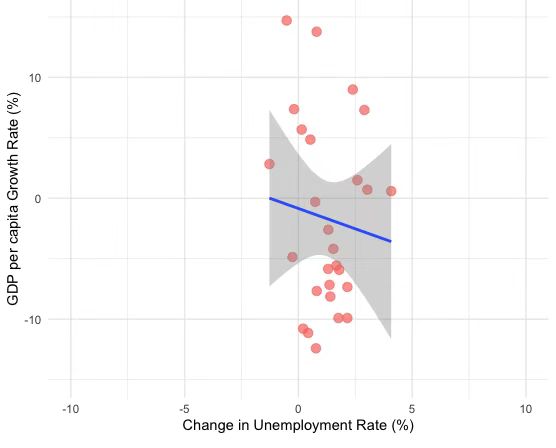
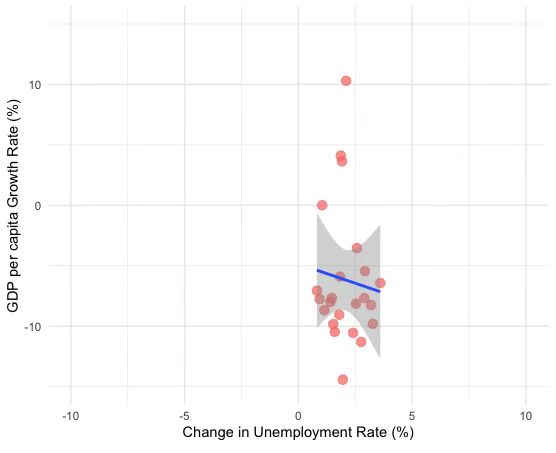
Figure 7: Change in unemployment rate vs GDP per capita growth rate (from left to right and top to bottom: United Kingdom, Germany, France, Japan, United States)
Note: The figures are arranged from left to right and top to bottom. Figure 7 shows the relationship between change in unemployment and GDP per capita growth rate in United Kingdom, Germany, France, Japan, and United States from 1992 to 2022. The red dots represent the observed data for each year, the blue line is the trend line obtained by regression fitting, indicating the linear relationship between the two, and the gray shaded area is the 95% confidence interval, showing the uncertainty range of the regression results. The figures are created by the author.
3.6. Further discussion: the influence of artificial intelligence on employment
In the context of the rapid development of artificial intelligence, the relationship between unemployment rate and economic development will take on new and more complex characteristics. AI may promote economic growth and reshape the employment structure, and may also cause periodic unemployment problems. The popularization of AI technology not only expands employment opportunities for high-skilled positions, but also poses a threat to some traditional positions.
In the short term, artificial intelligence will cause some jobs to disappear directly. In the future, AI will gradually replace current repetitive labor and some service industry jobs. For example, data entry clerks, assembly line workers, and manual customer service personnel may be replaced by robots. Emerging technologies such as unmanned retail and unmanned driving will impact employment in the service industry. In this way, AI will bring serious technological unemployment [7]. At the same time, AI may exacerbate unemployment imbalances. For example, talents will be concentrated in developed regions with developed economies and rich resources, while the unemployment rate in regions that rely on traditional industries will continue to rise. Traditional employees and low-skilled workers will face a higher risk of unemployment if they cannot master new skills. These circumstances will lead to accelerating economic development and a simultaneous increase in unemployment, and the applicability of Okun's law will become even worse.
The AI era not only brings challenges to employment issues, but also brings new opportunities. By improving production efficiency, AI promotes the optimization and upgrading of industrial structure and creates new high-quality jobs. Increased productivity can stimulate business expansion and create more jobs in the long term [8]. More jobs are emerging in AI-related fields, such as intelligent driving system engineers, algorithm engineers, image recognition/computer vision experts and other professionals. In the future, the job market's demand for analytical thinking, technical literacy, artificial intelligence and big data capabilities will continue to grow [9].
In general, the relationship between unemployment rate and economic development will be more complex in the future and will be constrained by more factors, such as the education system, government policies, and industrial structure adjustment. Economic development will no longer directly create a large number of new jobs, but will also replace traditional industries. The applicability of Okun's law will become worse in the short term. But in the long run, the creation of high-tech jobs and technological progress make Okun's law still applicable under certain circumstances. The more adjustments society makes to the employment problems brought about by the AI era and the more help it provides to the people, the faster the pace of innovation society can sustain [10]. The government and enterprises need to pay more attention to labor employment issues, provide more social security, reduce the substitution effect of AI on low-skilled industries, make AI an engine of economic growth, and adapt to future changes.
4. Conclusion
This paper explores the differences in the applicability of Okun's law among countries at different levels of economic development and the challenges they face in the era of artificial intelligence. The article divides countries into three categories according to their different economic development levels. It conducts a visual analysis of the relationship between unemployment rate and economic development in each category of economy and selects five typical countries in each category for specific data analysis. The results show that the negative correlation between unemployment and economic growth in Okun's law is not applicable to all countries even though it is widely established worldwide. This relationship is sometimes obscured by other factors. The applicability of Okun's law varies greatly in different regions and countries with different levels of economic development. The unemployment rate in developed economies is more affected by economic development. However, in poor and backward countries, due to factors such as a large number of informal jobs, weak social security, and resource-based industries where economic development cannot directly increase employment opportunities, the Okun's law relationship is weaker or the reverse relationship does not hold. The Okun coefficient is larger in some middle-income countries where the job market is more fragile.
In the AI era, employment opportunities and risks coexist. The replacement of traditional industries by artificial intelligence may make Okun's law ineffective in the short term. However, highly skilled, high-quality, and highly innovative talents still have core competitiveness in the market. The state and the government should maintain constant supervision of the education system and artificial intelligence so that artificial intelligence can truly improve productivity and enhance people's happiness.



